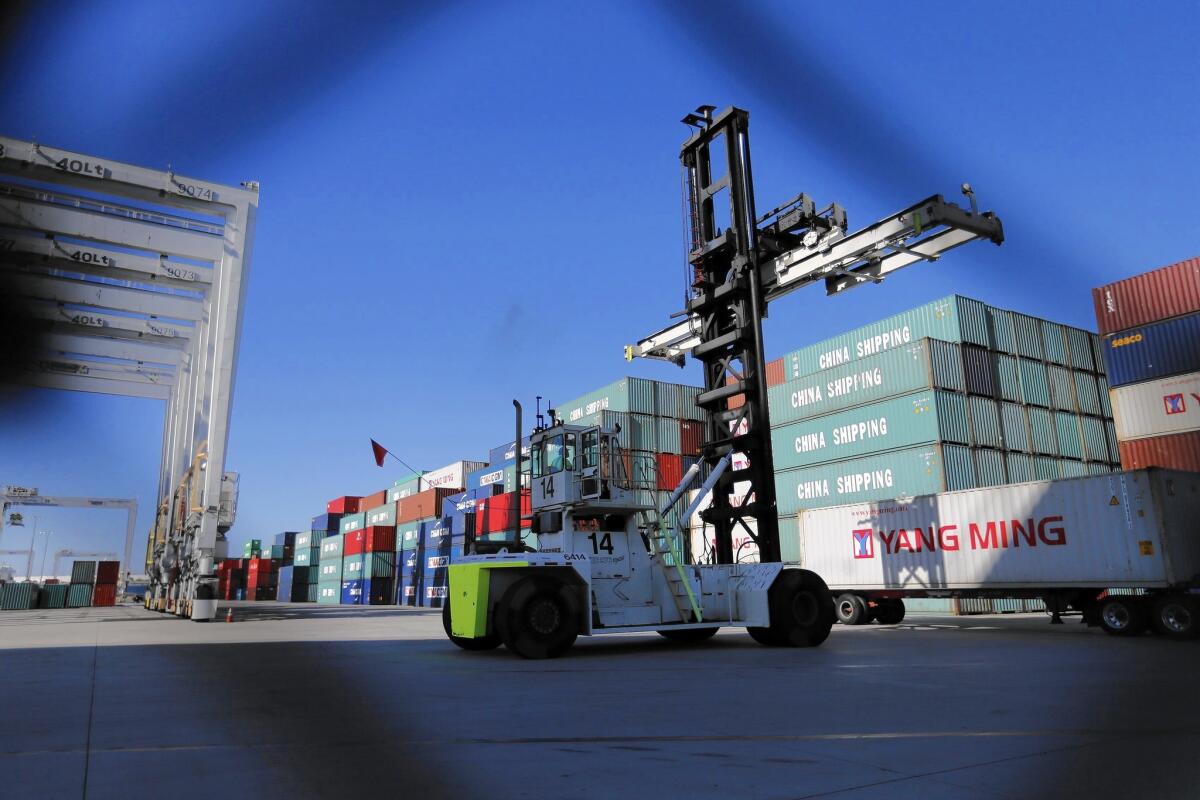Editorial: Americans can afford a few extra pennies on their Nikes to clean up ‘diesel death zones’

- Share via
The ports of Los Angeles and Long Beach may be among the greenest docks in the country, but they are still the single largest source of pollution in Southern California.
For the most part, fossil fuels power the host of ships, trains, heavy equipment and trucks that shuttle cargo between the ports, rail yards and warehouses. The concentration of all that pollution is toxic. Nearby communities, including Wilmington, San Pedro and West Long Beach, have the region’s highest cancer risk from air pollution, according to air quality regulators, and higher rates of asthma than the rest of the state. Communities along the highways used by the trucks have been dubbed “diesel death zones.”
In 2017, Los Angeles Mayor Eric Garcetti and Long Beach Mayor Robert Garcia pledged to transform the port complex into a zero-emissions facility by 2035. It’s an ambitious and expensive effort — $14 billion by one estimate — but absolutely essential to protect public health and cut planet-warming emissions. Now the mayors are facing the first test of their commitment.
The plan called for a fee on shipping containers both to raise money to help truckers buy cleaner vehicles and to incentivize them to switch sooner. The fee would be paid by cargo owners — including retailers, manufacturers and farmers — who would get a rebate if they hired cleaner trucks to transport their goods. But port officials have proposed pretty much the lowest fee possible, and that’s a serious problem.
Under the proposal being considered Monday, the L.A. and Long Beach ports would charge $20 per loaded 40-foot container, which is the standard size container these days. That would be no more than 1% of the cost to ship a container through the ports. The fee would generate about $90 million a year. That sounds like a lot of money, but it would help only around 900 of the more than 18,000 trucks serving the ports make the switch from diesel to cleaner natural gas each year.
An economic analysis found the ports could charge between $10 and $140 per container with minimal effect on their business. Above $140 per container, the companies that export and import goods would start shifting their cargo to other ports.
The proposed $20-per-container fee is also much less than what the ports charged a decade ago during the first effort to clean up port pollution. Then, the ports charged $70 per container carried on the oldest, dirtiest trucks. The program was controversial but it worked. Pollution from harbor trucks was slashed by more than 90% nearly three years ahead of schedule, although the emissions are still far too great. Hence the need for another round.
But this time is different, port officials argue. President Trump’s misguided trade war has already whittled cargo volumes and shifted manufacturing away from China toward other countries, such as Malaysia and Vietnam, that can use ports on the East Coast or in the Gulf of Mexico. Those ports have expanded and gained some of L.A. and Long Beach’s business. The prospect of a recession hangs over the economy. And now the coronavirus has dramatically slowed global trade, and who knows how long that will last.
So port officials are understandably cautious about imposing a new fee. They worry it will hurt port business, which will hurt the regional economy. Roughly 1 in 9 jobs in Southern California are tied to international trade through the ports.
But a low fee has its own shortcomings. At $20 a container, it could take more than 20 years to raise the money needed to convert all the dirty trucks. That’s bad for air quality and carbon emissions. It also doesn’t send a strong market signal to manufacturers to speed up development of near-zero and zero-emission trucks. Nor is the fee high enough to incentivize companies to switch to cleaner rigs to avoid paying the charge.
And there’s another reason to set a higher container fee. Southern California is facing a 2023 deadline to dramatically cut emissions to meet Clean Air Act standards or else face potentially hefty federal penalties, and it won’t pass that test without cleaning up trucks that use the ports. Air regulators have proposed a regional sales tax hike to pay for clean trucks and vehicles, but that would let the logistics industry shift the cost of cleaning up its dirty ways onto Southern California residents.
A container fee, on the other hand, would keep that cost where it belongs, on cargo owners and their customers. Shoppers can surely afford to pay a couple of extra pennies for their Nikes, their televisions and other imported goods to help clean up diesel death zones and fight climate change.
More to Read
A cure for the common opinion
Get thought-provoking perspectives with our weekly newsletter.
You may occasionally receive promotional content from the Los Angeles Times.










